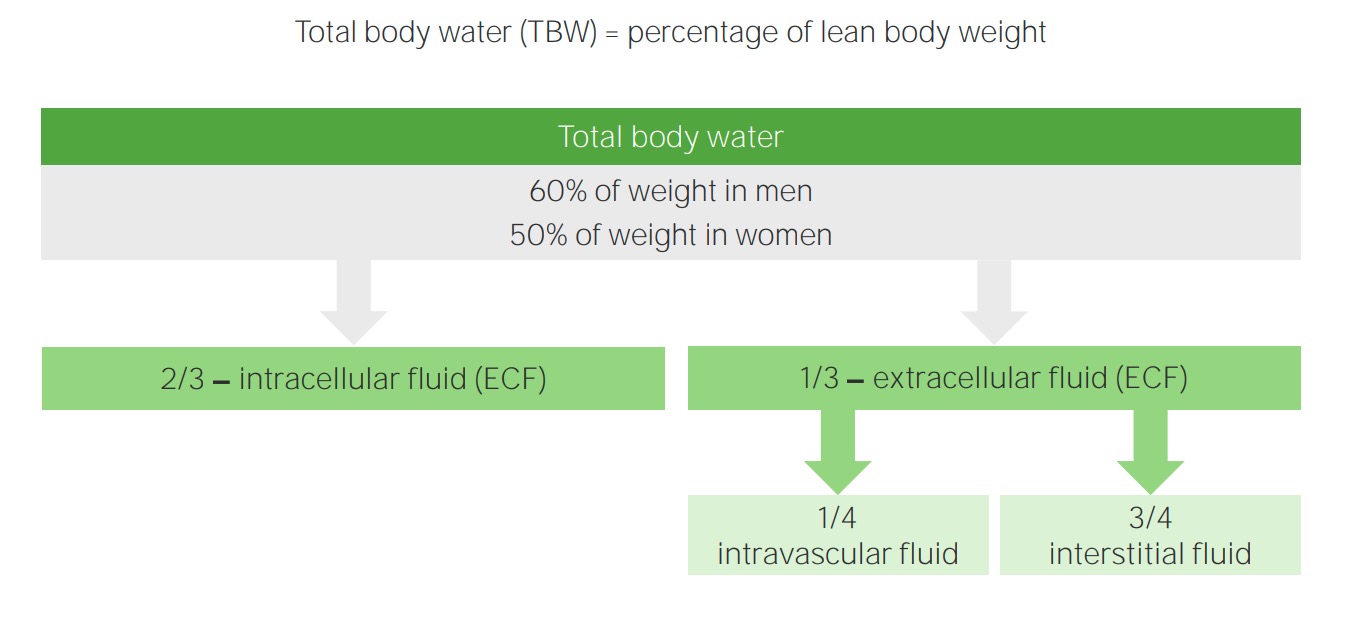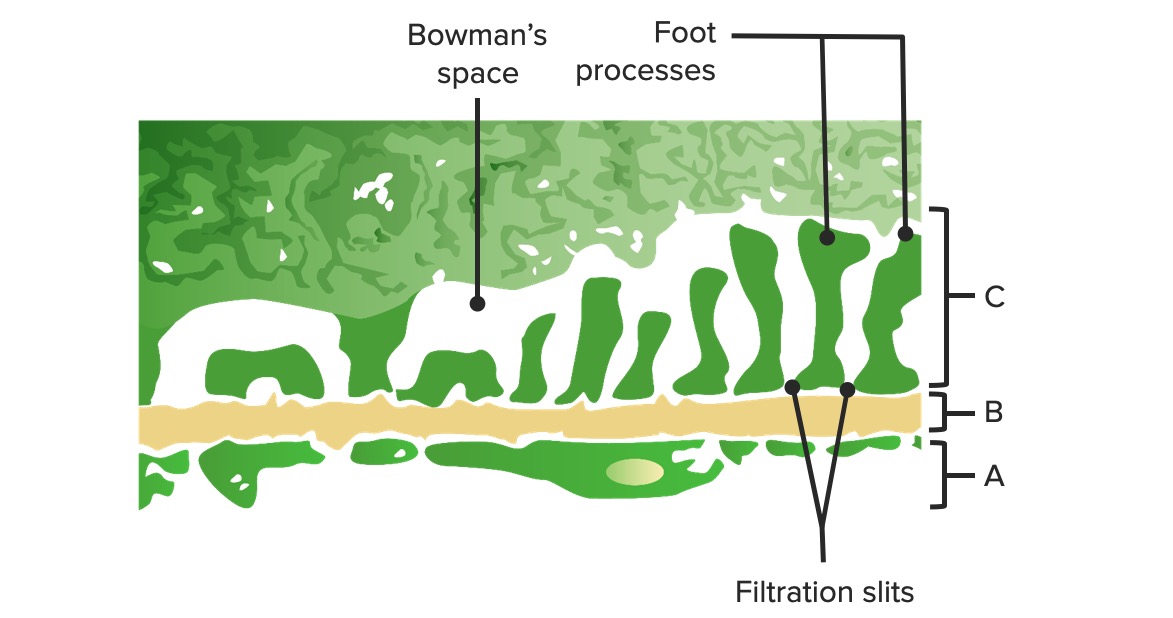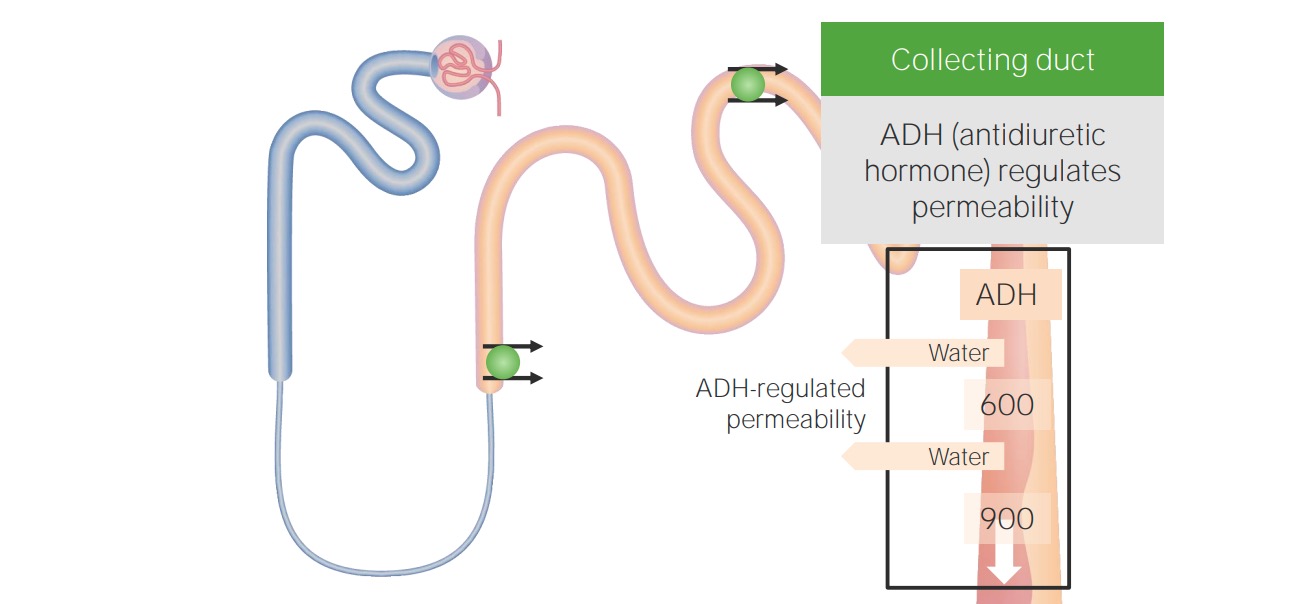Playlist
Show Playlist
Hide Playlist
Extracellular Fluid (ECF) & Intracellular Fluid (ICF)
-
Slides 04 MembraneExcitability GeneralPhysiology.pdf
-
Download Lecture Overview
00:01 So now let's take a couple of examples from cells that's representative of what's in our body. 00:09 So we have ECF which is extracellular fluid, that's the fluid around the cell. 00:14 And ICF, which is the intracellular fluid. 00:18 So if we take first, one particular ion, and we'll do this one at a time. 00:25 Sodium has a concentration outside the cell of around 145 mmol. Inside the cell, it's very low, about 12. 00:35 So there's a gradient across the membrane set up here. 00:41 If we look at potassium, it is high within the cell, about 120 mmol, versus 4 on the outside. 00:51 Calcium is what looks like to be low on both side, but in actuality, the extracellular fluid has more calcium than the intracellular fluid. 01:04 Intracellular fluid has almost none free calcium. 01:09 And finally we have chloride, which is high on the outside of the cell and low on the inside. 01:16 One of the things you should notice about these various molecules is their charge. 01:22 Sodium and potassium have a positive charge, and they have a +1. They're considered monovalent. 01:30 Calcium is a +2. It's divalent. And then chloride is an anion or negatively charged molecule. 01:40 The other thing to keep in mind is which direction the arrows are pointing. 01:45 You'll notice that they always point from the base of the highest number to the area of the lowest number. 01:51 Why? Because all these molecules want to get into equilibrium. Meaning that they'd be the same on both sides of the membrane. 02:00 That is their goal. They want to live in harmony and be the same on both sides of the membrane. 02:07 The membrane though, is going to be somewhat selective about which ones it allows to pass. 02:18 So we can calculate the exact voltage difference based upon those concentrations. 02:26 Now it's not important to be able to calculate this on a minute by minute basis. 02:31 There are only going to be numbers in which you have to be familiar with. 02:36 So for example, you see that this potential for sodium is around +61 mV. 02:46 So that's based upon the concentration in the extracellular fluid versus the intracellular fluid. 02:52 And you're gonna ask how in the world did you figure out that that was 61 mV. 02:58 You could have done it in two ways. 03:00 One of them, we could have put a reference electrode on one side of the membrane and then add electrode on the other side. 03:07 Or we can use a formulated calculator, which is called the Nernst equation. 03:13 At the Nernst equation, you take 61.5, divide it by the valence, times the log of the concentration inside the cell, over the concentration outside the cell. 03:26 So we either directly measuring it or using the Nernst equation, you can calculate the particular voltage that the concentration of those two ions inside and outside the membrane would cost. 03:43 If we look at potassium, you'll notice that it also has a voltage. 03:49 But the potassium potential comes out to be -90. Why? Because potassium was high inside the cell and low outside. 03:59 Calcium's membrane potential, very high. 120 in this particular example. 04:05 And again, that's based upon the ion concentration in either the measured value or the Nernst value. 04:12 Remember for the Nernst value, this one is going to be different because it's divalent. 04:17 So you're gonna have to take 61.5 divide it by now 2, because it has a +2 charge, times the log of the concentration on the inside over the concentration in the outside of the cell. 04:31 The final ion that we have here is chloride. And chloride is a -52 mV. 04:39 And remember that it has a higher concentration on the extracellular fluid than the intracellular fluid. 04:45 So the arrows become very important and their particular Nernst equation value becomes important. 04:53 So we have +61, +120, -90, and minus about 52. All from the ions that we had, or we directly measure them from the cell. 05:07 So that looks like there's four numbers here, what is the cell really at? Do we simply just add up all four of those and divide by four, so we get a mean? That would be too easy, wouldn't it? No. What we need to do is add another factor in play. 05:30 That other factor is which channels are opened, and which channels are closed. 05:35 Because again if you don't let the ions travel across, they don't count. 05:41 So we have to make sure which ions move becomes more important. 05:46 So let's start with calcium. 05:48 At rest, calcium is closed. Therefore we don't actualize that potential of 120. 05:59 Sodium channels also close at rest. Therefore that +61, non factor. 06:09 What is a factor? Potassium. Potassium channels are open at rest. Therefore, an excitable cell will have a negative membrane potential. 06:23 Because there's a conductant for potassium, it will be more likely close to the potassium equilibrium, which is -90. 06:33 So there will be some cells in the body that are at a -90 if these cells are opened all the time. 06:40 Most cells that were not at -90, they are a little bit above that, and that's because of one other factor, and that's the sodium-potassium pump, or the sodium-potassium ATPase which is constantly cycling and cycling and cycling, moving what? Potassium back into the cell and sodium out. 07:01 That is called electrogenic pump because it creates some electrical potential across the membrane. 07:09 Calcium pump is also there and that can also be part of the issue but it's primarily the sodium-potassium ATPase. 07:16 What we have is -70. You also notice that I didn't talk about chloride. 07:22 Chloride channels are also closed at this condition so they are not part of the membrane potential, just like calcium and sodium.
About the Lecture
The lecture Extracellular Fluid (ECF) & Intracellular Fluid (ICF) by Thad Wilson, PhD is from the course Membrane Physiology.
Included Quiz Questions
In a normal excitable cell, which of the following has a resting drive to leave the cell?
- Potassium
- Sodium
- Chloride
- Calcium
- HCO3⁻
Which of the following statements best describes the Nernst equation?
- Calculates the membrane potential at equilibrium between the two sides of the membrane for a particular ion
- Calculates the membrane potential at any given moment of cell activity
- Calculates the number of moles of electrons transferred across the membrane
- Calculates the total number of ions present in the cell
- Calculates the total number of ions transferred across the membrane
What is -61.5 in the Nernst equation?
- A constant
- A charge
- The potential for sodium
- The potential for chloride
- The temperature of the cell
Which of the following is true about ion concentration difference between ICF and ECF?
- Sodium concentration is higher in ECF.
- Potassium concentration is higher in ECF.
- Calcium concentration is higher in ICF.
- Sodium and calcium are primarily intracellular ions.
- Chloride concentration is higher in ICF.
Which channels are open at rest?
- Potassium
- Calcium
- Sodium
- Chloride
- Hydrogen
What is an electrogenic pump?
- A pump that creates an electrical potential across the membrane
- A hydrogen pump
- A pump that removes potassium from the cell
- A pump that allows glucose to enter the cell
- A pump that allows calcium in the cell
Which pump is electrogenic?
- Na/K ATPase
- A transporter
- A ligand-gated pump
- A channel protein
- An antiporter
In the Nernst equation, what is valence?
- The number of charges of a particular ion
- The intracellular concentration of a particular ion
- The extracellular concentrator of a particular ion
- The total number of ions crossing the membrane at a particular point in time
- The constant of temperature times the universal gas constant
Customer reviews
5,0 of 5 stars
| 5 Stars |
|
2 |
| 4 Stars |
|
0 |
| 3 Stars |
|
0 |
| 2 Stars |
|
0 |
| 1 Star |
|
0 |
it was a Great conference !! i understand it at once
wonderful lecture by Dr Thad Wilson...........i got a glimpse into the minute details of the topic as a whole..........thank u sir..............






